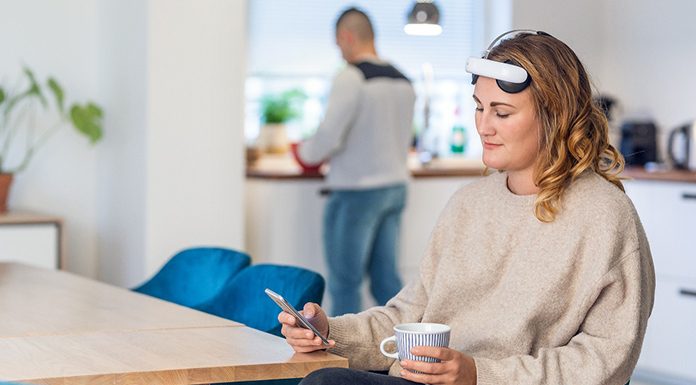
Flow, a medical device company, launches a medication-free device for treating depression comprising a brain stimulation headset and therapy app.
Brain stimulation has a similar impact to antidepressants, with fewer, less-severe side effects, therefore providing patients an alternative option for treating depression. The medical-grade brain stimulation headset and therapy app is the first at-home treatment of its kind in Europe.
Could brain stimulation be food for the mind?
The controlled trials published in the New England Journal of Medicine and the British Journal of Psychiatry shows that the device is the first approved treatment of its kind in Europe available to buy and use at home.
Flow is starting talks with the NHS to have its brain stimulation headset available on prescription. In 2019, Flow will also be working with the U.S. Food and Drug Administration (FDA) to seek regulatory clearance in the U.S.
People diagnosed with depression often have a lower neural activity in their left frontal lobe, the part of the brain controlling important cognitive skills, including emotional expression. The Flow headset uses transcranial direct current stimulation (tDCS), a form of neurostimulation that delivers constant, low direct current via electrodes on the head to stimulate neurons in this area and help rebalance activity. The brain stimulation delivered in the Flow headset is technically and clinically equivalent to devices used in these randomised controlled trials.
Andre Russowsky Brunoni, Psychiatrist, Associate Professor at the University of São Paulo Medical School, Brazil and co-author of the study said: “By combining tDCS with behavioural therapy, the Flow team has created a powerful medical device treatment. I have seen first-hand the possibilities this technique has in providing a treatment for unipolar depression without the several adverse effects associated with pharmacological therapies.”
Treating depression with stimulation
In Europe, Flow is classified as a Class II medical device by the British Standards Institute, intended for use as a treatment for depression and possibly even anxiety relief. Treatment typically lasts for 30 minutes per session, with 18 sessions over 6 weeks. Continued treatment is then possible for 1-2 sessions per week.
During brain stimulation, users engage with a virtual therapist, via an app. This features videos and advice about depression, and how to reduce symptoms, using recent expert knowledge from the fields of sleep, nutrition, fitness and meditation.
Daniel Mansson, Co-Founder and CEO of Flow, said: “We want to support the improvement of the current standard of care for people living with depression by increasing treatment choice and empowering patients to self-manage their symptoms at home with effective, non-pharmacological, alternatives.”
About Flow
Based in Sweden, Flow was developed by clinical psychologist Daniel Mansson and neuroscientist Erik Rehn, together with a team of prominent researchers in the field of psychiatry and brain stimulation.
Founded in 2016, the company combines clinical psychology, neuroscience and innovative technology, including machine learning, and works with experts in the mental health field to create an interdisciplinary physical and behavioural treatment for depression.
Reference
- Brunoni, A. R., Moffa, A. H., Sampaio-Junior, B., Borrione, L., Moreno, M. L., Fernandes, R. A., Benseñor, I. M. (2017). Trial of Electrical Direct-Current Therapy versus Escitalopram for Depression. New England Journal of Medicine (26), 2523–2533. https://doi.org/10.1056/NEJMoa1612999
- Brunoni, A. R., Moffa, A. H., Fregni, F., Palm, U., Padberg, F., Blumberger, D. M., … Loo, C. K. (2016). Transcranial direct current stimulation for acute major depressive episodes: meta-analysis of individual patient data. The British Journal of Psychiatry : The Journal of Mental Science, 208(6), 522–531. https://doi.org/10.1192/bjp.bp.115.164715
- Bikson et al., Safety of Transcranial Direct Current Stimulation: Evidence Based Update 2016. Brain Stimulation, 9(2016), 641–661. http://dx.doi.org/10.1016/j.brs.2016.06.004
- Julian Mutz, Vijeinika Vipulananthan, Ben Carter, René Hurlemann, Cynthia H Y Fu, Allan H Young. (2019). Comparative efficacy and acceptability of non-surgical brain stimulation for the acute treatment of major depressive episodes in adults: systematic review and network meta-analysis. BMJ 2019;364:l1079 http://dx.doi.org/10.1136/bmj.l1079
- WHO Depression key facts https://www.who.int/news-room/fact-sheets/detail/depression
- NHS England: Mental Health https://www.england.nhs.uk/mental-health/
- Office for National Statistics (2015). Suicides in the United Kingdom https://www.ons.gov.uk/peoplepopulationandcommunity/birthsdeathsandmarriages/deaths/bulletins/suicidesintheunitedkingdom/2015-02-19
- Department of Health: No health without mental health https://assets.publishing.service.gov.uk/government/uploads/system/uploads/attachment_data/file/215808/dh_123993.pdf
Flow
Tweet @flowneurosci
www.flowneuroscience.com






















